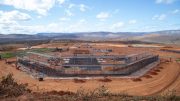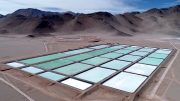Russia’s state nuclear group Rosatom and Canada’s Wealth Minerals (TSXV: WML) are working towards a partnership at the junior’s Atacama lithium project in northern Chile. The two companies signed a memorandum of understanding (MOU) under which Rosatom, through its subsidiary Uranium One Group, can earn up to a 51% stake in the project along with the right to purchase 100% of its offtake.
The MOU would give Wealth Minerals access to Rosatom’s technology, which dispenses with the massive solar evaporation ponds that are used to extract lithium from the brine in high-altitude salars or basins. Rosatom’s sorption technology, by contrast, employs a reusable catalyst material that attracts the lithium salt without using any heat in the process.
The catalyst material adheres itself to the lithium and can then effectively be washed off and re-used. The remaining water — the brine without the lithium — is then pumped back into the salar.
“Solar evaporation requires enormous ponds to be bulldozed and left in place — they’re huge — you can see them from outer space,” says Tim McCutcheon, Wealth Minerals’ president. “You’re in the driest part of the planet and you’re evaporating water off into the atmosphere … This technology ensures that the water table in the salar doesn’t fall. It’s really a breakthrough to the problem of recovering lithium in an ecologically friendly way and being competitive in terms of costs,” he continues. “The trick here is their catalyst material, which by the way it has been formed can perform the recovery process without introducing heat.”
McCutcheon acknowledges that other companies are experimenting with similar technologies, but says Uranium One’s is much more advanced. When pressed for details of the catalyst material, he said he couldn’t go into any specifics. “It’s a big state corporation, so they’re a little allergic to disclosure because it’s not something they do — and this transaction for their size and scale is very small, so I can’t tell you more.”
The priority now is for Rosatom to complete its due diligence on the Atacama project, and advance the MOU to a definitive agreement. McCutcheon says that while the deal was really technology-driven, the nuclear giant group through Uranium One was also one of the few companies to think creatively and “step up to the plate.”
“The reason they’re getting involved in the lithium space is that there are bigger plans to work down the value chain to higher value-added projects, and the offtake component of our MOU make that obvious,” he says. “The lithium space is all about providing energy solutions, because the key thing about lithium ion batteries is that it allows you to manage energy inventory and storage … so in those terms this deal wasn’t surprising at all … one reason they got into the uranium space is because they were building nuclear reactors all over the world, and it makes sense for them to provide fuel to their customers. So they’re taking that one step further and saying, ‘What other energy solutions can we provide?’ — and that’s what makes it kind of neat.”
By contrast, he says, when Wealth Minerals approached other large companies as strategic partners, management got nowhere. “We reached out to fertilizer companies, because if you can team up with one of those they have a use for potassium, which also comes from the same source as lithium, and so lithium would simply be an additional revenue stream for their existing business, but none of them really wanted to step up to the plate. Then we talked to battery makers, but they don’t want anything to do with the actual mining side, and they want a turnkey project…then we went to chemical companies because lithium is also used as a lubricant, but those conversations didn’t go very far.
“The opportunity for lithium companies is [that] your potential audience of strategic investors is huge, but you don’t know who you should be talking to,” he adds. “If you’re a little gold company you aspire to being a Barrick. For a junior lithium company, you don’t really know what to aspire to be. Albermarle has a wide spectrum of products they sell and lithium is just one of them, and SQM started out as a chemical fertilizer company. That’s what’s exciting about Uranium One. There’s a clear vision to get involved in this industry and do things right from the very beginning, which is why this is the first thing they have done with a lithium raw material asset, but they already had the technology beforehand, so it has been a methodically planned out vision, and we’re pretty excited to be part of it. And it’s a pretty big corporation to have as your partner — they have 250,000 employees.”
At the same time, demand for lithium for lithium ion batteries will only grow. A report by Wood Mackenzie released on Oct. 28 noted that more than US$350 million was invested in advanced lithium-ion technologies during the first half of 2019.
“What makes the lithium space an outlier or different than everything else is there really aren’t a lot of supply solutions for people,” McCutcheon says. “Two mines — Greenbushes and the Atacama operations run by Albermarle and Sociedad Quimica y Minera de Chile (NYSE: SQM) — represent almost 70% of global production. So the reason why companies are backward integrating and securing raw material is because it’s pretty clear there might not be enough raw material to go around.”
Wealth Minerals’ Atacama concessions cover an area of 462 sq. km in the northern part of the Atacama Salar in Region II of Chile. The Salar de Atacama hosts more than 15% of the world’s known lithium reserves, but exploration and production of lithium has occurred only in the southern part of the salar, McCutcheon says.
“As the Atacama salar is one big geological structure, and based on our geophysical work, we are confident we will have similar material on our property package as the material being exploited directly to the south of us, about 15 km away, at operations run by SQM and Albemarle,” McCutcheon says. “Those operations have lithium bearing material grading at over 1,800 parts per million lithium, which is exponentially higher than anything else currently in production.”
Rosatom took control of Uranium One in January 2013, and the company was delisted from the Toronto Stock Exchange in October 2013.






Be the first to comment on "Wealth Minerals and Rosatom sign MOU"